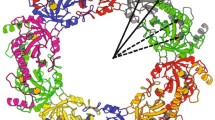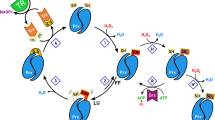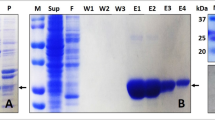Abstract
Peroxiredoxins carry out the efficient reduction of a typically broad range of peroxide substrates through an absolutely conserved, activated cysteine residue within a highly conserved active site pocket structure. Though details of reductive recycling after cysteine sulfenic acid formation at the active site vary among members of different Prx classes, local unfolding around the active site cysteine is likely generally required in these proteins for disulfide bond formation with a second resolving cysteine and/or for access of the reductant to the oxidized active site. The conformational change associated with the catalytic cycle and the redox-dependent decamer formation occurring in at least some typical 2-Cys Prxs have interesting implications in the interplay between active site loop dynamics, oligomerization state, catalytic efficiency and propensity toward inactivation during turnover in these important antioxidant enzymes
Access this chapter
Tax calculation will be finalised at checkout
Purchases are for personal use only
Preview
Unable to display preview. Download preview PDF.
Similar content being viewed by others
References
Akerman, S.E., and MÜller, S., 2005, Peroxiredoxin-linked detoxification of hydroperoxides in Toxoplasma gondii. J. Biol. Chem. 280: 564–570.
Alphey, M.S., Bond, C.S., Tetaud, E., Fairlamb, A.H., and Hunter, W.N., 2000, The structure of reduced tryparedoxin peroxidase reveals a decamer and insight into reactivity of 2Cys-peroxiredoxins. J. Mol. Biol. 300: 903–916.
Baker, L.M., and Poole, L.B., 2003, Catalytic mechanism of thiol peroxidase from Escherichia coli. Sulfenic acid formation and overoxidation of essential CYS61. J Biol. Chem. 278: 9203–9211.
Biteau, B., Labarre, J., and Toledano, M.B., 2003, ATP-dependent reduction of cysteine-sulphinic acid by S. cerevisiae sulphiredoxin. Nature 425: 980–984.
Breinig, S., Kervinen, J., Stith, L., Wasson, A.S., Fairman, R., Wlodawer, A., Zdanov, A., and Jaffe, E.K., 2003, Control of tetrapyrrole biosynthesis by alternate quaternary forms of porphobilinogen synthase. Nat. Struct. Biol. 10: 757–763.
Bryk, R., Griffin, P., and Nathan, C., 2000, Peroxynitrite reductase activity of bacterial peroxiredoxins. Nature 407: 211–215.
Bryk, R., Lima, C.D., Erdjument-Bromage, H., Tempst, P., and Nathan, C., 2002, Metabolic enzymes of mycobacteria linked to antioxidant defense by a thioredoxin-like protein. Science 295: 1073–1077.
Budanov, A.V., Sablina, A.A., Feinstein, E., Koonin, E.V., and Chumakov, P.M., 2004, Regeneration of peroxiredoxins by p53-regulated sestrins, homologs of bacterial AhpD. Science 304: 596–600.
Budde, H., Flohé, L., Hecht, H.J., Hofmann, B., Stehr, M., Wissing, J., and Lünsdorf, H., 2003a, Kinetics and redox-sensitive oligomerisation reveal negative subunit cooperativity in tryparedoxin peroxidase of Trypanosoma brucei brucei. Biol. Chem. 384: 619–633.
Budde, H., Flohé, L., Hofmann, B., and Nimtz, M., 2003b, Verification of the interaction of a tryparedoxin peroxidase with tryparedoxin by ESI-MS/MS. Biol. Chem. 384: 1305–1309.
Cha, M.K., Kim, W.C., Lim, C.J., Kim, K., and Kim, I.H., 2004, Escherichia coli periplasmic thiol peroxidase acts as lipid hydroperoxide peroxidase and the principal antioxidative function during anaerobic growth. J. Biol. Chem. 279: 8769–8778.
Cha, M.K., Yun, C.H., and Kim, I.H., 2000, Interaction of human thiol-specific antioxidant protein 1 with erythrocyte plasma membrane. Biochemistry 39: 6944–6950.
Chae, H.Z., Chung, S.J., and Rhee, S.G., 1994, Thioredoxin-dependent peroxide reductase from yeast. J. Biol. Chem. 269: 27670–27678.
Chae, H.Z., Robison, K., Poole, L.B., Church, G., Storz, G., and Rhee, S.G., 1994, Cloning and sequencing of thiol-specific antioxidant from mammalian brain: alkyl hydroperoxide reductase and thiol-specific antioxidant define a large family of antioxidant enzymes. Proc. Natl. Acad. Sci. USA 91: 7017–7021.
Chang, T.S., Jeong, W., Choi, S.Y., Yu, S., Kang, S.W., and Rhee, S.G., 2002, Regulation of peroxiredoxin I activity by Cdc2-mediated phosphorylation. J Biol Chem 277: 25370–25376.
Chauhan, R., and Mande, S.C., 2001, Characterization of the Mycobacterium tuberculosis H37Rv alkyl hydroperoxidase AhpC points to the importance of ionic interactions in oligomerization and activity. Biochem. J. 354: 209–215.
Chen, J.W., Dodia, C., Feinstein, S.I., Jain, M.K., and Fisher, A.B., 2000, 1-Cys peroxiredoxin, a bifunctional enzyme with glutathione peroxidase and phospholipase A2 activities. J. Biol. Chem. 275: 28421–28427.
Choi, H.J., Kang, S.W., Yang, C.H., Rhee, S.G., and Ryu, S.E., 1998, Crystal structure of a novel human peroxidase enzyme at 2.0 A resolution. Nat Struct. Biol. 5: 400–406.
Choi, Y.O., Cheong, N.E., Lee, K.O., Jung, B.G., Hong, C.H., Jeong, J.H., Chi, Y.H., Kim, K., Cho, M.J., and Lee, S.Y., 1999, Cloning and expression of a new isotype of the peroxiredoxin gene of Chinese cabbage and its comparison to 2Cys-peroxiredoxin isolated from the same plant. Biochem. Biophys. Res. Commun. 258: 768–771.
Christman, M.F., Morgan, R.W., Jacobson, F.S., and Ames, B.N., 1985, Positive control of a regulon for defenses against oxidative stress and some heat-shock proteins in Salmonella typhimurium. Cell 41: 753–762.
Comtois, S.L., Gidley, M.D., and Kelly, D.J., 2003, Role of the thioredoxin system and the thiol-peroxidases Tpx and Bcp in mediating resistance to oxidative and nitrosative stress in Helicobacter pylori Microbiology 149: 121–129.
Copley, S.D., Novak, W.R., and Babbitt, P.C., 2004, Divergence of function in the thioredoxin fold suprafamily: evidence for evolution of peroxiredoxins from a thioredoxin-like ancestor. Biochemistry 43: 13981–13995.
Deponte, M., and Becker, K., 2005, Biochemical characterization of Toxoplasma gondii 1-Cys peroxiredoxin 2 with mechanistic similarities to typical 2-Cys Prx. Mol. Biochem. Parasitol. 140: 87–96.
Dietz, K.J., 2003, Plant peroxiredoxins. Annu. Rev. Plant Biol. 54: 93–107.
Dubuisson, M., Vander Stricht, D., Clippe, A., Etienne, F., Nauser, T., Kissner, R., Koppenol, W.H., Rees, J.F., and Knoops, B., 2004, Human peroxiredoxin 5 is a peroxynitrite reductase. FEBS Lett. 571: 161–165.
Ellis, H.R., and Poole, L.B., 1997, Roles for the two cysteine residues of AhpC in catalysis of peroxide reduction by alkyl hydroperoxide reductase from Salmonella typhimurium. Biochemistry 36:13349–13356.
Ferrante, A.A., Augliera, J., Lewis, K., and Klibanov, A.M., 1995, Cloning of an organic solvent-resistance gene in Escherichia coli: the unexpected role of alkylhydroperoxide reductase. Proc. Natl. Acad. Sci. U S A 92: 7617–7621.
Fisher, A.B., Dodia, C., Manevich, Y., Chen, J.W., and Feinstein, S.I., 1999, Phospholipid hydroperoxides are substrates for non-selenium glutathione peroxidase. J. Biol. Chem. 274: 21326–21334.
Flohé, L., Budde, H., Bruns, K., Castro, H., Clos, J., Hofmann, B., Kansal-Kalavar, S., Krumme, D., Menge, U., Plank-Schumacher, K., Sztajer, H., Wissing, J., Wylegalla, C., and Hecht, H.J., 2002, Tryparedoxin peroxidase of Leishmania donovani: molecular cloning, heterologous expression, specificity, and catalytic mechanism. Arch. Biochem. Biophys. 397: 324–335.
Fomenko, D.E., and Gladyshev, V.N., 2003, Identity and functions of CxxC-derived motifs. Biochemistry 42: 11214–11225.
Greenberg, J.T., and Demple, B., 1988, Overproduction of peroxide-scavenging enzymes in Escherichia coli suppresses spontaneous mutagenesis and sensitivity to redox-cycling agents in oxyR-mutants. Embo J. 7: 2611–2617.
Hirotsu, S., Abe, Y., Okada, K., Nagahara, N., Hori, H., Nishino, T., and Hakoshima, T., 1999, Crystal structure of a multifunctional 2-Cys peroxiredoxin heme-binding protein 23kDa/proliferation-associated gene product. Proc. Natl. Acad. Sci. U S A 96: 12333–12338.
Hofmann, B., Hecht, H.-J., and Flohé, L., 2002, Peroxiredoxins. Biol Chem 383: 347–364.
Jacobson, F.S., Morgan, R.W., Christman, M.F., and Ames, B.N., 1989, An alkyl hydroperoxide reductase from Salmonella typhimurium involved in the defense of DNA against oxidative damage. Purification and properties. J. Biol. Chem. 264: 1488–1496.
Jaeger, T., Budde, H., Flohé, L., Menge, U., Singh, M., Trujillo, M., and Radi, R., 2004, Multiple thioredoxin-mediated routes to detoxify hydroperoxides in Mycobacterium tuberculosis. Arch. Biochem. Biophys. 423: 182–191.
Jang, H.H., Lee, K.O., Chi, Y.H., Jung, B.G., Park, S.K., Park, J.H., Lee, J.R., Lee, S.S., Moon, J.C., Yun, J.W., Choi, Y.O., Kim, W.Y., Kang, J.S., Cheong, G.W., Yun, D.J., Rhee, S.G., Cho, M.J., and Lee, S.Y., 2004, Two enzymes in one; two yeast peroxiredoxins display oxidative stress-dependent switching from a peroxidase to a molecular chaperone function. Cell 117: 625–635.
Jeong, J.S., Kwon, S.J., Kang, S.W., Rhee, S.G., and Kim, K., 1999, Purification and characterization of a second type thioredoxin peroxidase (type II TPx) from Saccharomyces cerevisiae. Biochemistry 38: 776–783.
Jeong, W., Cha, M.K., and Kim, I.H., 2000, Thioredoxin-dependent hydroperoxide peroxidase activity of bacterioferritin comigratory protein (BCP) as a new member of the thiol-specific antioxidant protein (TSA)/Alkyl hydroperoxide peroxidase C (AhpC) family. J. Biol. Chem. 275: 2924–2930.
Kang, S.W., Baines, I.C., and Rhee, S.G., 1998, Characterization of a mammalian peroxiredoxin that contains one conserved cysteine. J Biol Chem 273: 6303–6311.
Kim, K., Kim, I.H., Lee, K.Y., Rhee, S.G., and Stadtman, E.R., 1988, The isolation and purification of a specific "protector" protein which inhibits enzyme inactivation by a thiol/Fe(III)/O2 mixed-function oxidation system. J. Biol. Chem. 263: 4704–4711.
Kim, S.J., Woo, J.R., Hwang, Y.S., Jeong, D.G., Shin, D.H., Kim, K., and Ryu, S.E., 2003, The tetrameric structure of Haemophilus influenza hybrid Prx5 reveals interactions between electron donor and acceptor proteins. J. Biol. Chem. 278: 10790–10798.
Kitano, K., Niimura, Y., Nishiyama, Y., and Miki, K., 1999, Stimulation of peroxidase activity by decamerization related to ionic strength: AhpC protein from Amphibacillus xylanus. J. Biochem. (Tokyo) 126: 313–319.
Kong, W., Shiota, S., Shi, Y., Nakayama, H., and Nakayama, K., 2000, A novel peroxiredoxin of the plant Sedum lineare is a homologue of Escherichia coli bacterioferritin co-migratory protein (Bcp). Biochem. J. 351: 107–114.
König, J., Baier, M., Horling, F., Kahmann, U., Harris, G., Schurmann, P., and Dietz, K.J., 2002, The plant-specific function of 2-Cys peroxiredoxin-mediated detoxification of peroxides in the redox-hierarchy of photosynthetic electron flux. Proc. Natl. Acad. Sci. U S A 99: 5738–5743.
König, J., Lotte, K., Plessow, R., Brockhinke, A., Baier, M., and Dietz, K.J., 2003, Reaction mechanism of plant 2-Cys peroxiredoxin. Role of the C terminus and the quaternary structure. J. Biol. Chem. 278: 24409–24420.
Koo, K.H., Lee, S., Jeong, S.Y., Kim, E.T., Kim, H.J., Song, K., and Chae, H.-Z., 2002, Regulation of thioredoxin peroxidase activity by C-terminal truncation. Arch. Biochem. Biophys. 397: 312–318.
Koshkin, A., Nunn, C.M., Djordjevic, S., and Ortiz de Montellano, P.R., 2003, The mechanism of Mycobacterium tuberculosis alkylhydroperoxidase AhpD as defined by mutagenesis, crystallography, and kinetics. J. Biol. Chem. 278: 29502–29508.
Kristensen, P., Rasmussen, D.E., and Kristensen, B.I., 1999, Properties of thiol-specific anti-oxidant protein or calpromotin in solution. Biochem. Biophys. Res. Commun. 262: 127–131.
Lee, J., Spector, D., Godon, C., Labarre, J., and Toledano, M.B., 1999, A new antioxidant with alkyl hydroperoxide defense properties in yeast. J. Biol. Chem. 274: 4537–4544.
Manevich, Y., Feinstein, S.I., and Fisher, A.B., 2004, Activation of the antioxidant enzyme 1-CYS peroxiredoxin requires glutathionylation mediated by heterodimerization with pi GST. Proc. Natl. Acad. Sci. U S A 101: 3780–3785.
Meissner, U., Schröder, E., Scheffler, D., Martin, A.G., and Harris, J.R., 2006, Formation, TEM study and 3D reconstruction of the human erythrocyte peroxiredoxin-2 dodecahedral higher-order assembly. Micron, 38: 29–39.
Mitsumoto, A., Takanezawa, Y., Okawa, K., Iwamatsu, A., and Nakagawa, Y., 2001, Variants of peroxiredoxins expression in response to hydroperoxide stress. Free Radic. Biol. Med 30: 625–635.
Montemartini, M., Kalisz, H.M., Hecht, H.J., Steinert, P., and Flohé, L., 1999, Activation of active-site cysteine residues in the peroxiredoxin-type tryparedoxin peroxidase of Crithidia fasciculata. Eur. J. Biochem. 264: 516–524.
Moon, J.C., Hah, Y.S., Kim, W.Y., Jung, B.G., Jang, H.H., Lee, J.R., Kim, S.Y., Lee, Y.M., Jeon, M.G., Kim, C.W., Cho, M.J., and Lee, S.Y., 2005, Oxidative stress-dependent structural and functional switching of a human 2-Cys peroxiredoxin isotype II that enhances HeLa cell resistance to H2O2-induced cell death. J. Biol. Chem. 280: 28775–28784.
Nogoceke, E., Gommel, D.U., Kiess, M., Kalisz, H.M., and Flohe, L., 1997, A unique cascade of oxidoreductases catalyses trypanothione-mediated peroxide metabolism in Crithidia fasciculata. Biol Chem 378: 827–836.
Nunn, C.M., Djordjevic, S., Hillas, P.J., Nishida, C.R., and Ortiz de Montellano, P.R., 2002, The crystal structure of Mycobacterium tuberculosis alkylhydroperoxidase AhpD, a potential target for antitubercular drug design. J. Biol. Chem. 277: 20033–20040.
Park, S.G., Cha, M.K., Jeong, W., and Kim, I.H., 2000, Distinct physiological functions of thiol peroxidase isoenzymes in Saccharomyces cerevisiae. J. Biol. Chem. 275: 5723–5732.
Parsonage, D., Youngblood, D.S., Sarma, G.N., Wood, Z.A., Karplus, P.A., and Poole, L.B., 2005, Analysis of the link between enzymatic activity and oligomeric state in AhpC, a bacterial peroxiredoxin. Biochemistry 44: 10583–10592.
Pedrajas, J.R., Miranda-Vizuete, A., Javanmardy, N., Gustafsson, J.A., and Spyrou, G., 2000, Mitochondria of Saccharomyces cerevisiae contain one-conserved cysteine type peroxiredoxin with thioredoxin peroxidase activity. J. Biol. Chem. 275: 16296–16301.
Peshenko, I.V., and Shichi, H., 2001, Oxidation of active center cysteine of bovine 1-Cys peroxiredoxin to the cysteine sulfenic acid form by peroxide and peroxynitrite. Free Radic. Biol. Med. 31: 292–303.
Plishker, G.A., Chevalier, D., Seinsoth, L., and Moore, R.B., 1992, Calcium-activated potassium transport and high molecular weight forms of calpromotin. J. Biol. Chem. 267: 21839–21843.
Poole, L.B., 1999, Flavin-linked redox components required for AhpC reduction in alkyl hydroperoxide reductase systems. In Flavins and Flavoproteins 1999 (Ghisla, S., Kroneck, P., Macheroux, P., and Sund, H., eds), Agency for Scientific Publications, Berlin, pp. 691–694.
Poole, L.B., 2003, Bacterial peroxiredoxins. In Signal Transduction by Reactive Oxygen and Nitrogen Species: Pathways and Chemical Principles (Torres, M., Fukuto, J. M., and Forman, H. J., eds), Kluwer Academic Publishers, Dordrecht, The Netherlands, pp. 80–101.
Poole, L.B., 2005, Bacterial defenses against oxidants: mechanistic features of cysteine-based peroxidases and their flavoprotein reductases. Arch. Biochem. Biophys. 433: 240–254.
Poole, L.B., Reynolds, C.M., Wood, Z.A., Karplus, P.A., Ellis, H.R., and Li Calzi, M., 2000, AhpF and other NADH:peroxiredoxin oxidoreductases, homologues of low Mr thioredoxin reductase. Eur. J. Biochem. 267: 6126–6133.
Rabilloud, T., Heller, M., Gasnier, F., Luche, S., Rey, C., Aebersold, R., Benahmed, M., Louisot, P., and Lunardi, J., 2002, Proteomics analysis of cellular response to oxidative stress. Evidence for in vivo overoxidation of peroxiredoxins at their active site. J. Biol. Chem. 277: 19396–19401.
Ralat, L.A., Manevich, Y., Fisher, A.B., and Colman, R.F., 2006, Direct evidence for the formation of a complex between 1-cysteine peroxiredoxin and glutathione S-transferase pi with activity changes in both enzymes. Biochemistry 45: 360–372.
Reynolds, C.M., Meyer, J., and Poole, L.B., 2002, An NADH-dependent bacterial thioredoxin reductase-like protein in conjunction with a glutaredoxin homologue form a unique peroxiredoxin (AhpC) reducing system in Clostridium pasteurianum. Biochemistry 41: 1990–2001.
Rhee, S.G., Chae, H.Z., and Kim, K., 2005, Peroxiredoxins: a historical overview and speculative preview of novel mechanisms and emerging concepts in cell signaling. Free Radic. Biol. Med. 38: 1543–1552.
Rouhier, N., Gelhaye, E., Gualberto, J.M., Jordy, M.N., De Fay, E., Hirasawa, M., Duplessis, S., Lemaire, S.D., Frey, P., Martin, F., Manieri, W., Knaff, D.B., and Jacquot, J.P., 2004, Poplar peroxiredoxin Q. A thioredoxin-linked chloroplast antioxidant functional in pathogen defense. Plant Physiol. 134: 1027–1038.
Rouhier, N., Gelhaye, E., and Jacquot, J.P., 2002, Glutaredoxin-dependent peroxiredoxin from poplar: protein-protein interaction and catalytic mechanism. J. Biol. Chem. 277: 13609–13614.
Rouhier, N., and Jacquot, J.P., 2005, The plant multigenic family of thiol peroxidases. Free Radic. Biol. Med. 38: 1413–1421.
Sarma, G.N., Nickel, C., Rahlfs, S., Fischer, M., Becker, K., and Karplus, P.A., 2005, Crystal structure of a novel Plasmodium falciparum 1-Cys peroxiredoxin. J. Mol. Biol. 346: 1021–1034.
Sayed, A.A., and Williams, D.L., 2004, Biochemical characterization of 2-Cys peroxiredoxins from Schistosoma mansoni. J. Biol. Chem. 279: 26159–26166.
Schröder, E., Littlechild, J.A., Lebedev, A.A., Errington, N., Vagin, A.A., and Isupov, M.N., 2000, Crystal structure of decameric 2-Cys peroxiredoxin from human erythrocytes at 1.7 Å resolution. Structure 8: 605–615.
Schröder, E., Willis, A.C., and Ponting, C.P., 1998, Porcine natural-killer-enhancing factor-B: oligomerisation and identification as a calpain substrate in vitro. Biochim. Biophys. Acta 1383: 279–291.
Seaver, L.C., and Imlay, J.A., 2001, Alkyl hydroperoxide reductase is the primary scavenger of endogenous hydrogen peroxide in Escherichia coli. J. Bacteriol 183: 7173–7181.
Söhling, B., Parther, T., Rucknagel, K.P., Wagner, M.A., and Andreesen, J.R., 2001, A selenocysteine-containing peroxiredoxin from the strictly anaerobic organism Eubacterium acidaminophilum. Biol. Chem. 382: 979–986.
Torchinsky, Y.M., 1981, Properties of SH groups, in Sulfur in Proteins (Metzler, D., ed), Pergamon, Oxford, England
Trujillo, M., Budde, H., Pineyro, M.D., Stehr, M., Robello, C., Flohé, L., and Radi, R., 2004, Trypanosoma brucei and Trypanosoma cruzi tryparedoxin peroxidases catalytically detoxify peroxynitrite via oxidation of fast reacting thiols. J. Biol. Chem. 279: 34175–34182.
Trujillo, M., Mauri, P., Benazzi, L., Comini, M., De Palma, A., Flohé, L., Radi, R., Stehr, M., Singh, M., Ursini, F., and Jaeger, T., 2006, The mycobacterial thioredoxin peroxidase can act as a one-cysteine-peroxiredoxin. J. Biol. Chem.
Verdoucq, L., Vignols, F., Jacquot, J.P., Chartier, Y., and Meyer, Y., 1999, In vivo characterization of a thioredoxin h target protein defines a new peroxiredoxin family. J. Biol. Chem. 274: 19714–19722.
Vergauwen, B., Pauwels, F., Jacquemotte, F., Meyer, T.E., Cusanovich, M.A., Bartsch, R.G., and Van Beeumen, J.J., 2001, Characterization of glutathione amide reductase from Chromatium gracile. Identification of a novel thiol peroxidase (Prx/Grx) fueled by glutathione amide redox cycling. J. Biol. Chem. 276: 20890–20897.
Winterbourn, C.C., and Metodiewa, D., 1999, Reactivity of biologically important thiol compounds with superoxide and hydrogen peroxide. Free Radic. Biol. Med. 27: 322–328.
Wood, Z.A., Poole, L.B., Hantgan, R.R., and Karplus, P.A., 2002, Dimers to doughnuts: redox-sensitive oligomerization of 2-cysteine peroxiredoxins. Biochemistry 41: 5493–5504.
Wood, Z.A., Poole, L.B., and Karplus, P.A., 2003a, Peroxiredoxin evolution and the regulation of hydrogen peroxide signaling. Science 300: 650–653.
Wood, Z.A., Schröder, E., Harris, J.R., and Poole, L.B., 2003b, Structure, mechanism and regulation of peroxiredoxins. Trends Biochem. Sci. 28: 32–40.
Yang, K.S., Kang, S.W., Woo, H.A., Hwang, S.C., Chae, H.Z., Kim, K., and Rhee, S.G., 2002, Inactivation of human peroxiredoxin I during catalysis as the result of the oxidation of the catalytic site cysteine to cysteine-sulfinic acid. J. Biol. Chem. 277: 38029–38036.
Author information
Authors and Affiliations
Editor information
Editors and Affiliations
Rights and permissions
Copyright information
© 2007 Springer
About this chapter
Cite this chapter
Poole, L.B. (2007). The Catalytic Mechanism of Peroxiredoxins. In: Flohé, L., Harris, J.R. (eds) Peroxiredoxin Systems. Subcellular Biochemistry, vol 44. Springer, Dordrecht. https://doi.org/10.1007/978-1-4020-6051-9_4
Download citation
DOI: https://doi.org/10.1007/978-1-4020-6051-9_4
Publisher Name: Springer, Dordrecht
Print ISBN: 978-1-4020-6050-2
Online ISBN: 978-1-4020-6051-9
eBook Packages: Biomedical and Life SciencesBiomedical and Life Sciences (R0)




